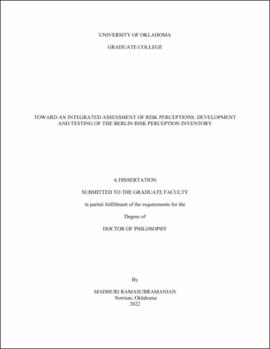| dc.description.abstract | Research across four decades in psychology has suggested that risk perceptions can often be multi-dimensional, reflecting psychological constructs such as dread (how severe the consequences tend to be) and unknown (knowledge about risks; Fischhoff et al., 1978). However, research has largely neglected the assessment and integration of these dimensions across different orientations of risk perceptions (i.e., general versus specific risk perceptions; societal versus personal risk perceptions; absolute versus relative risk perceptions). As such, the current set of studies aimed to distill a brief psychometric scale to robustly measure diverse, multi-dimensional perceptions of risk to society: The Berlin Risk Perception Inventory (BRPI). Study 1 used Item Response Theory to distill a brief, robust measure of individual differences in societal risk perceptions from previously established standards. Structural analyses revealed that the BRPI explained between 2-3 times more variance in specific risks across emerging domains of weather, cybersecurity and health/safety compared to the original form. Study 2 conducted a successful out of sample replication and validation of the BRPI and demonstrated novel evidence in explaining perceptions of personal risks (i.e., how risky is HIV for me, personally). Study 3 tested the brief scale amidst a truly novel and unprecedented risk: COVID-19. Results revealed that this 3-minute instrument robustly explained both societal and personal perceptions of COVID-19, and downstream consequences (i.e., knowledge and behavioral intentions). General discussion focuses on providing analytic frameworks for measuring general, specific, societal, and personal risk perceptions. Finally, some of the earliest evidence on the measurement of relative risk perceptions of COVID-19 is discussed, with findings suggesting that failure to use the BRPI may result in studies with biased estimates of risk perceptions. | en_US |
